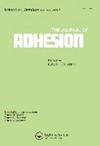Capillary forces and capillary bridges between a three-finger microgripper and a plate
IF 2.3
4区 材料科学
Q2 ENGINEERING, CHEMICAL
引用次数: 1
Abstract
ABSTRACT The presence of surface tension in liquids, which induces a strong capillary force between wetting particles in micro/nano scale, has aroused extensive attention. In present study, a fundamental investigation on capillary forces and rupture behaviors of capillary bridges between a three-finger microgripper and a plate is conducted in quasi-static state. Theoretical analysis is performed for solutions of the capillary force. The capillary bridges between a three-finger microgripper and a plate are established based on the principle of energy minimization. An analytical approach for computing the capillary force for the three-finger/plate geometry is proposed by means of variables obtained from the simulation models. The comparison of the single-finger capillary bridge and three-finger capillary bridge is investigated based on the developed models. The effects of separation distance, capillary bridge volume, radial distance and contact angle on the capillary force of three-finger capillary bridges are analyzed in detail. The results demonstrate that the variation of capillary force with separation distance and volume changing is not monotonic, which is caused by the edge effect of the three-finger microgripper. Capillary force measurements were experimentally characterized to demonstrate the reliability of the simulation models and the capillary force solution method based on an established experimental platform.毛细管力和毛细管桥之间的三指微夹钳和板
液体中存在的表面张力在微纳尺度上引起了湿润颗粒之间强大的毛细力,引起了广泛的关注。本文在准静态状态下,对三指微夹持器与板间毛细管桥的毛细管力和断裂行为进行了基础研究。对毛细管力的解进行了理论分析。基于能量最小化原理,建立了三指微夹持器与平板之间的毛细管桥。本文提出了一种利用仿真模型中得到的变量计算三指/板几何毛细力的解析方法。在此基础上,对单指毛细管桥和三指毛细管桥进行了比较研究。详细分析了分离距离、毛细管桥体积、径向距离和接触角对三指毛细管桥毛细管力的影响。结果表明,毛细管力随分离距离和体积变化的变化不是单调的,这是由三指微夹持器的边缘效应引起的。对毛细管力测量结果进行了实验表征,验证了仿真模型和毛细管力求解方法的可靠性。
本文章由计算机程序翻译,如有差异,请以英文原文为准。
求助全文
约1分钟内获得全文
求助全文
来源期刊

Journal of Adhesion
工程技术-材料科学:综合
CiteScore
5.30
自引率
9.10%
发文量
55
审稿时长
1 months
期刊介绍:
The Journal of Adhesion is dedicated to perpetuating understanding of the phenomenon of adhesion and its practical applications. The art of adhesion is maturing into a science that requires a broad, coordinated interdisciplinary effort to help illuminate its complex nature and numerous manifestations.
 求助内容:
求助内容: 应助结果提醒方式:
应助结果提醒方式:


